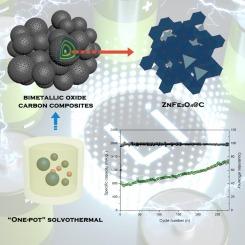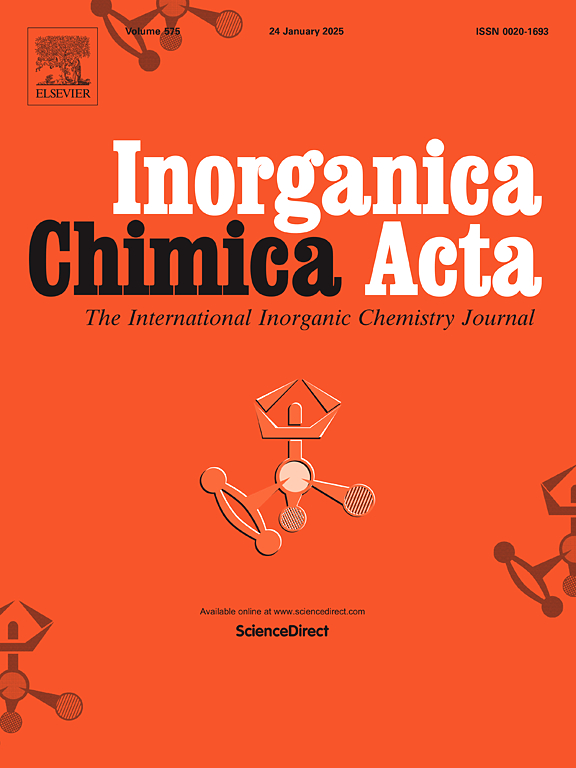Iron-based bimetallic oxide carbon composites with superior lithium storage capabilities serve as anode in lithium-ion batteries
IF 2.7
3区 化学
Q2 CHEMISTRY, INORGANIC & NUCLEAR
引用次数: 0
Abstract
Transition metal oxides (TMOs) have emerged as highly promising electrode materials for lithium-ion batteries (LIBs) owing to their versatile valence states and distinctive morphological attributes. Bimetallic oxides, in particular, exhibit the ability to mitigate the volume expansion associated with lithium alloying and de-alloying processes. Despite these advantages, metal oxides often suffer from drawbacks such as poor conductivity, limited cycle stability, and a propensity for lithiation. Addressing the challenges of low electronic conductivity, significant volume expansion, and inadequate uniformity, we synthesized two bimetallic oxide-based carbon composites via a “one-pot” solvothermal approach: ZnFe2O4@C and MnFe2O4@C. These composites are enveloped in a carbon shell derived from anhydrous ethanol. Notably, the specific discharge capacities of ZnFe2O4@C and MnFe2O4@C surpass those of their respective single metal oxide counterparts. Following nearly 300 cycles of charge and discharge operations at a current density of 100 mA g−1, ZnFe2O4@C exhibited a specific discharge capacity of 1528 mAh g−1, while MnFe2O4@C demonstrated a capacity of 1283 mAh g−1. The synthesis method offers simplicity, high yield, and uniform morphology, making it a promising avenue for enhancing the performance of LIBs electrode materials.

铁基双金属氧化物碳复合材料具有卓越的锂存储能力,可用作锂离子电池的负极
过渡金属氧化物(TMOs)因其多价态和独特的形态属性,已成为极具潜力的锂离子电池(LIBs)电极材料。尤其是双金属氧化物,能够缓解与锂合金化和去合金化过程相关的体积膨胀。尽管具有这些优点,金属氧化物通常仍存在一些缺点,如导电性差、循环稳定性有限以及容易锂化。为了解决电子导电率低、体积膨胀大和均匀性不足等难题,我们通过 "一锅 "溶热法合成了两种基于双金属氧化物的碳复合材料:ZnFe2O4@C 和 MnFe2O4@C。这些复合材料被包裹在由无水乙醇提取的碳壳中。值得注意的是,ZnFe2O4@C 和 MnFe2O4@C 的比放电容量超过了各自的单一金属氧化物。在电流密度为 100 mA g-1 的条件下进行近 300 次充放电操作后,ZnFe2O4@C 的特定放电容量为 1528 mAh g-1,而 MnFe2O4@C 的容量为 1283 mAh g-1。该合成方法简单、产率高、形貌均匀,是提高 LIBs 电极材料性能的一个很有前景的途径。
本文章由计算机程序翻译,如有差异,请以英文原文为准。
求助全文
约1分钟内获得全文
求助全文
来源期刊

Inorganica Chimica Acta
化学-无机化学与核化学
CiteScore
6.00
自引率
3.60%
发文量
440
审稿时长
35 days
期刊介绍:
Inorganica Chimica Acta is an established international forum for all aspects of advanced Inorganic Chemistry. Original papers of high scientific level and interest are published in the form of Articles and Reviews.
Topics covered include:
• chemistry of the main group elements and the d- and f-block metals, including the synthesis, characterization and reactivity of coordination, organometallic, biomimetic, supramolecular coordination compounds, including associated computational studies;
• synthesis, physico-chemical properties, applications of molecule-based nano-scaled clusters and nanomaterials designed using the principles of coordination chemistry, as well as coordination polymers (CPs), metal-organic frameworks (MOFs), metal-organic polyhedra (MPOs);
• reaction mechanisms and physico-chemical investigations computational studies of metalloenzymes and their models;
• applications of inorganic compounds, metallodrugs and molecule-based materials.
Papers composed primarily of structural reports will typically not be considered for publication.
 求助内容:
求助内容: 应助结果提醒方式:
应助结果提醒方式:


